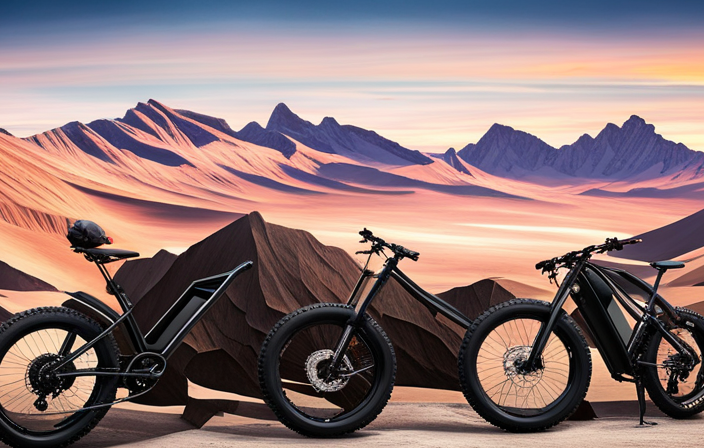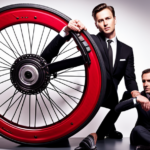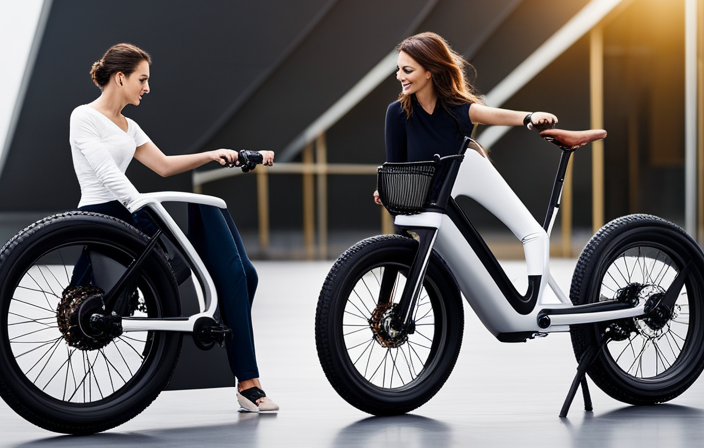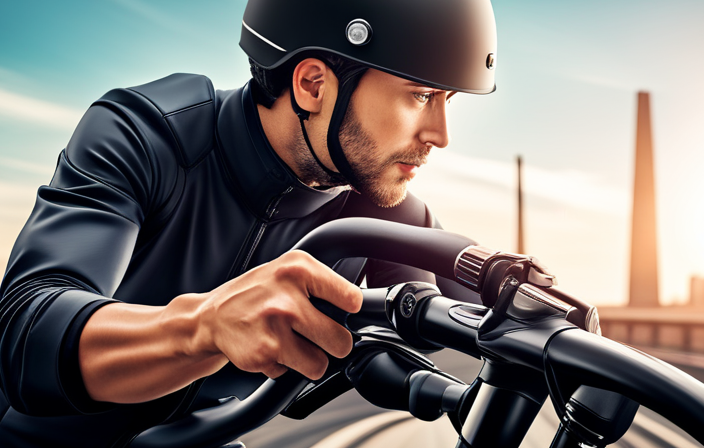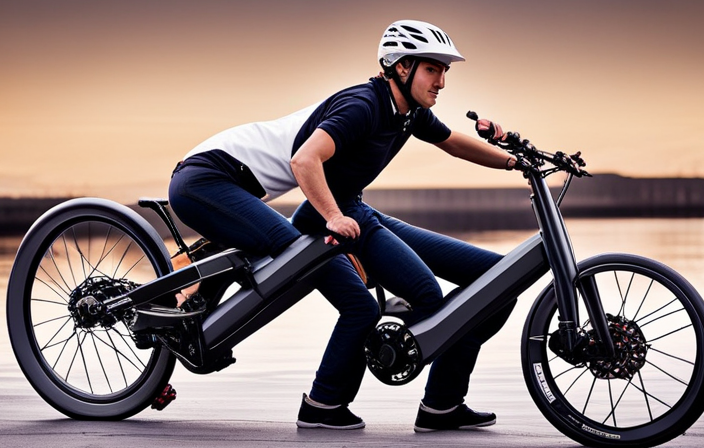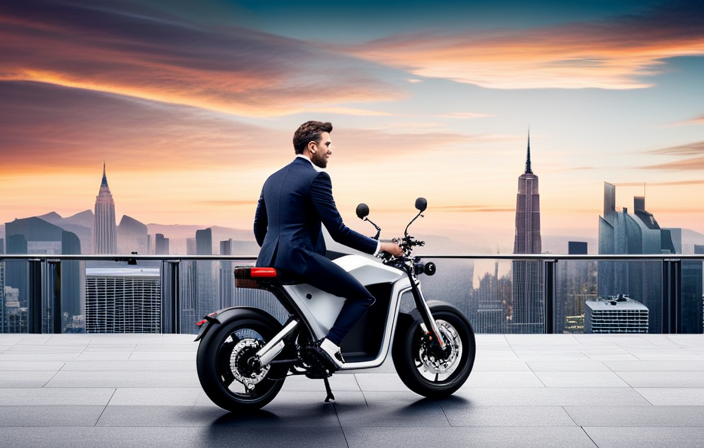Did you know that electric bike sales have skyrocketed by 145% in the past year? With the increasing popularity of electric bikes, it’s important to know how to assemble one correctly.
In this step-by-step guide, you will learn how to unbox your electric bike, check for any damage or missing parts, and properly attach the handlebars and front wheel. Follow these instructions carefully, and soon you’ll be ready to take your new electric bike for a spin.
Key Takeaways
- Electric bike sales have seen a significant increase of 145% in the past year.
- When choosing an electric bike, consider factors such as battery life, motor power, and weight capacity.
- It is important to carefully inspect the bike for any damage or missing parts before assembly.
- Reading the instruction manual is crucial to understand the bike’s features, assembly process, safety precautions, and troubleshooting guidelines.
Unboxing Your Electric Bike
Before you start assembling your electric bike, you should unbox it first.
Start by choosing the right electric bike for your needs. Consider factors such as battery life, motor power, and weight capacity.
Once you have your electric bike, find a clean and spacious area to unbox it. Carefully remove all the packaging materials, making sure not to damage any parts. Inspect the bike for any visible damage or missing parts. Check the frame for scratches or dents, and ensure that the wheels are properly aligned. Take note of any issues and contact the manufacturer if necessary.
Additionally, read the user manual to familiarize yourself with the bike’s features and operation.
Following these steps will help ensure a smooth assembly process.
Checking for Damage or Missing Parts
After checking for damage or missing parts, make sure to thoroughly inspect all components. Identifying common issues with electric bike components is crucial for troubleshooting and fixing minor damages. Here are three key steps to help you in this process:
-
Examine the frame: Look for any cracks, dents, or paint chips on the frame. Ensure that all welds are intact and there are no signs of corrosion.
-
Check the wheels and tires: Inspect the wheels for any wobbling or loose spokes. Verify that the tires are properly inflated and have no cuts or punctures.
-
Test the electrical system: Check the battery for any signs of damage or leakage. Inspect the wiring for frayed or exposed areas. Turn on the bike and verify that the lights, display, and throttle are functioning correctly.
By following these steps, you can troubleshoot and fix minor damages on your electric bike.
Now, let’s move on to the next section about reading the instruction manual, where you will find more detailed guidance.
Reading the Instruction Manual
To properly understand how to operate your e-bike, it is essential to read the instruction manual. This manual provides crucial information on the assembly process, safety precautions, and troubleshooting common issues that may arise during assembly.
Following the safety precautions outlined in the manual is of utmost importance to ensure your safety and the proper functioning of the electric bike. It is recommended to wear protective gear such as a helmet and gloves while assembling the bike.
The manual also provides troubleshooting tips for common assembly issues, such as loose connections or improper alignment of components. By carefully following the instructions and troubleshooting guidelines, you can avoid potential problems and ensure a smooth assembly process.
Now, let’s move on to the next section, which covers attaching the handlebars.
Attaching the Handlebars
Attaching the handlebars is a crucial step in the assembly process of your e-bike.
Start by locating the stem on the front fork of your bike frame. Loosen the stem bolt using a hex key, and position the handlebars in alignment with the front wheel. Tighten the stem bolt firmly to secure the handlebars in place.
Next, install the handlebar grips by sliding them onto the ends of the handlebars. Ensure they are evenly positioned and fully pushed onto the handlebars.
To adjust the handlebar angle, loosen the stem bolt slightly and use your hands to rotate the handlebars to your desired position. Tighten the stem bolt again to secure the angle adjustment.
With the handlebars securely attached, you can now move on to mounting the front wheel, ensuring a smooth and safe ride.
Mounting the Front Wheel
Now that you’ve successfully attached the handlebars, let’s move on to mounting the front wheel for a smooth and safe ride. Follow these step-by-step instructions to ensure a proper installation:
- Begin by placing the front wheel in front of the bike frame, aligning the axle with the dropouts on the fork.
- Slide the axle into the dropouts, making sure it is fully seated.
- Tighten the nuts or quick-release mechanism on both sides of the axle using a wrench or your hands, ensuring the wheel is secure.
Once the front wheel is properly mounted, you can proceed to install the front fender and adjust the front wheel alignment for optimal performance.
To connect the brake cables, please refer to the subsequent section.
Connecting the Brake Cables
After successfully mounting the front wheel, the next step is to connect the brake cables. This is a crucial step in ensuring the functionality and safety of your electric bike. To properly connect the brake cables, you need to familiarize yourself with the different brake pad materials available. Some common options include organic, semi-metallic, and metallic brake pads. Each material has its own advantages and disadvantages, so choose the one that best suits your needs and riding style. Once you have selected the appropriate brake pads, carefully attach them to the brake calipers, making sure they are aligned correctly. If you encounter any issues during this process, such as loose cables or improper alignment, consult the troubleshooting section of your bike’s manual for guidance. Now that the brake cables are connected, you are ready to move on to the next step: installing the pedals and completing the assembly of your electric bike.
Installing the Pedals
To properly install the pedals, make sure to align the threads correctly and tighten them securely.
Start by locating the left and right pedals, which are typically labeled. The left pedal has reverse threads, so remember to turn it counterclockwise to tighten.
Begin by threading the left pedal into the left crank arm, ensuring it is aligned properly. Use a pedal wrench or a 15mm wrench to tighten it securely.
Repeat the same process for the right pedal, turning it clockwise to tighten.
Once both pedals are installed, it’s important to adjust the pedal height. Stand next to the bike and position the pedal at the lowest point. Align the ball of your foot with the center of the pedal axle.
To adjust the seat height, continue to the next step and secure it to your desired height.
Adjusting the Seat Height
Make sure you adjust the seat height to your desired level for a comfortable riding experience. To adjust the seat height, follow these steps:
- Start by loosening the seatpost clamp using an Allen wrench.
- Once the clamp is loose, adjust the seat height by raising or lowering it.
- Make sure the seatpost is inserted into the seat tube at least the minimum insertion mark for safety.
- Tighten the clamp securely to hold the seat in place.
Adjusting the seat angle is also important for comfort and proper riding posture. To adjust the seat angle, follow these steps:
- Loosen the seat angle adjustment bolt located underneath the seat.
- Tilt the seat forward or backward to your preference.
- Tighten the bolt securely to lock the seat angle in place.
Choosing the right seat height and angle will ensure optimal comfort and efficiency while riding your electric bike. Now, let’s move on to the next step of attaching the battery.
Attaching the Battery
Attach the battery to your electric bike by following these steps:
- Locate the battery compartment on your electric bike frame.
- Ensure that the battery is fully charged before attaching it.
- Carefully align the battery connectors with the corresponding connectors on the bike frame.
- Gently push the battery into the compartment until it clicks into place.
- Double-check that the battery is securely attached and won’t come loose during rides.
Proper battery charging and maintenance are crucial for optimal performance and longevity of your electric bike. Remember to follow the manufacturer’s instructions for charging the battery and avoid overcharging it, as this can lead to reduced battery life. Additionally, regularly inspect the battery for any signs of damage or wear, such as cracks or corrosion, and address any issues promptly.
Now that the battery is securely attached, let’s move on to connecting the motor and controller.
Connecting the Motor and Controller
Once the battery is securely attached, it’s time to connect the motor and controller. Start by locating the motor wiring connectors on both the motor and the controller. Ensure that the connectors match and insert them together firmly. Double-check the connection to make sure it is secure and tight.
Next, refer to the wiring diagram provided with the electric bike kit to connect the wires from the motor to the corresponding terminals on the controller. Follow the diagram step-by-step, making sure to connect each wire correctly.
Once all the wires are connected, it’s important to test the connection and troubleshoot any issues with the controller. Check for any loose or disconnected wires, and ensure that the motor is receiving power. This will ensure that the motor and controller are properly connected and ready for the next step, testing the electrical components.
Testing the Electrical Components
To properly test the electrical components, you should first ensure that all the wires are securely connected and that the motor is receiving power. Here are the testing procedures and troubleshooting techniques you can follow:
-
Check the connections: Examine all the wires and connectors to make sure they are firmly connected and there are no loose connections.
-
Test the power supply: Use a multimeter to check if the motor is receiving the correct voltage from the battery or power source.
-
Test the controller: Connect the controller to the power supply and check if it is functioning properly. Ensure that all the buttons and controls are responsive.
-
Test the motor: Apply power to the motor and observe its performance. Check if it is running smoothly and without any unusual noise or vibrations.
By following these testing procedures and troubleshooting techniques, you can ensure that all the electrical components of your electric bike are functioning optimally.
Now, let’s move on to adjusting the gears and brakes to complete the assembly process seamlessly.
Adjusting the Gears and Brakes
Now, you need to make sure the gears and brakes are properly adjusted.
Proper maintenance of these components is crucial for a smooth and safe ride on your electric bike.
Start by checking the gear shifting mechanism. Shift through all the gears to ensure they engage smoothly without any skipping or hesitation. If you encounter any issues, try troubleshooting common problems like cable tension or limit screw adjustment.
Next, focus on the brakes. Squeeze the brake levers and make sure they engage smoothly and provide sufficient stopping power. Adjust the brake pads if necessary, ensuring they are aligned with the rim and have proper clearance.
Lastly, to transition into the subsequent section about inflating the tires, it’s important to have properly adjusted gears and brakes before moving on to other maintenance tasks.
Inflating the Tires
Make sure you check the tire pressure and inflate them to the recommended level. Proper tire maintenance for electric bikes is crucial for optimal performance and safety.
Choosing the right tire pressure for your electric bike is essential, as it affects the bike’s handling, comfort, and efficiency. Here are three key points to consider:
-
Safety: Maintaining proper tire pressure ensures a secure grip on the road, reducing the risk of accidents.
-
Comfort: By inflating the tires to the recommended level, you’ll enjoy a smoother ride, minimizing vibrations and bumps.
-
Battery Efficiency: Keeping the tires properly inflated reduces rolling resistance, allowing your electric bike’s battery to last longer.
Once you’ve inflated the tires, it’s time to move on to the next step of checking and adjusting the suspension to further optimize your riding experience.
Checking and Adjusting the Suspension
After inflating the tires, it’s important to check and adjust the suspension for an optimal riding experience.
Start by adjusting the suspension settings to match your weight and riding style. Most electric bikes have adjustable suspension forks that allow you to fine-tune the compression and rebound damping.
Use a suspension pump to set the sag, which is the amount the suspension compresses under your weight.
Troubleshoot common suspension issues like excessive bouncing or bottoming out by adjusting the compression and rebound settings accordingly. If the suspension is too soft, increase the compression damping. If it’s too firm, decrease it. Similarly, adjust the rebound damping to control how the suspension returns to its normal position after compressing.
Once you’ve adjusted the suspension, you’re ready to take your first ride and experience the smooth and comfortable ride quality.
Taking Your First Ride
Once you’ve adjusted the suspension, hop on and take your first ride to experience the thrill of electric biking. Before you start, make sure to avoid these common beginner mistakes:
-
Find the right riding position: Adjust the seat height so that your feet can comfortably touch the ground while sitting on the saddle. Maintain a slight bend in your knees when the pedals are in the 3 o’clock and 9 o’clock positions. This ensures optimal power transfer and reduces strain on your joints.
-
Start slowly: Gradually apply pressure to the pedals to get a feel for the motor assistance. Keep a firm grip on the handlebars and maintain a relaxed posture.
-
Practice braking: Get a sense of the bike’s stopping power by gently squeezing the brake levers. Remember to use both brakes evenly and gradually increase the force as you become more comfortable.
-
Be aware of your surroundings: Stay alert and keep an eye out for potential obstacles, pedestrians, and other vehicles. Always use hand signals when turning or changing lanes.
By following these steps, you’ll be able to enjoy your first electric bike ride while avoiding common beginner mistakes and finding the perfect riding position.
Get ready for an exhilarating adventure!
Frequently Asked Questions
How long does it take to fully charge the electric bike battery?
To fully charge the electric bike battery, the charging time depends on the battery capacity. Typically, the charging process takes around 4-6 hours for a standard battery. However, high-capacity batteries may take longer, up to 8-10 hours.
It is important to use the provided charger and follow the manufacturer’s instructions for optimal charging. Ensure a proper power source and avoid overcharging to maintain battery longevity.
What is the recommended weight limit for the electric bike?
The recommended weight limit for the electric bike is crucial to ensure optimal performance and safety. It refers to the maximum weight that the bike can handle without compromising its stability or damaging its components.
It is important to adhere to this limit to prevent accidents and extend the lifespan of the bike. Exceeding the recommended weight limit can strain the motor, battery, and frame, potentially causing issues and reducing the bike’s overall efficiency and durability.
Can I ride the electric bike in the rain?
Yes, you can ride the electric bike in the rain, but it’s important to use proper riding technique and have waterproof accessories.
When riding in wet conditions, maintain a balanced posture and avoid sudden movements to prevent slipping.
Make sure your bike is equipped with fenders to keep water from splashing onto you.
Additionally, invest in a waterproof cover for the battery and controller to protect them from moisture damage.
How often should I clean and maintain the electric bike?
To ensure optimal performance and longevity of your electric bike, regular cleaning and maintenance are crucial. Cleaning frequency will depend on usage and weather conditions, but a general guideline is to clean your bike every 2-4 weeks.
Start by wiping down the frame and components with a damp cloth, then use a mild soap solution to remove dirt and grime. Pay special attention to the chain, gears, and brakes.
Don’t forget to lubricate the chain and check tire pressure regularly.
Are there any specific safety precautions I should take while riding the electric bike?
When riding your electric bike, it’s crucial to prioritize safety. To ensure a safe ride, follow these riding techniques:
- Maintain a steady speed.
- Use both hands on the handlebars.
- Keep a safe distance from other vehicles.
Additionally, always wear the proper gear, including a helmet, gloves, and reflective clothing. These precautions will help protect you from potential accidents and ensure a smooth and enjoyable ride.
Conclusion
Congratulations! You’ve successfully assembled your electric bike and you’re ready to embark on exciting adventures. Just like a skilled conductor leading a symphony, you’ve orchestrated the perfect harmony between all the components of your bike.
With each step completed, you’ve crafted a masterpiece on two wheels. As you pedal forward, the wind whispers in your ear, reminding you that you’re now the captain of your electric steed, ready to conquer new horizons.
Enjoy the ride!

